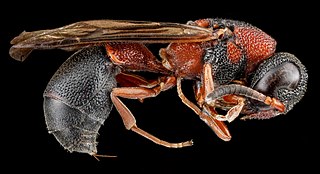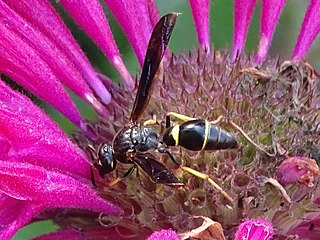
Leptochilus is a large, mostly Holarctic genus of small sized potter wasps. The genus reaches its largest diversity in the Palearctic where there are more than 135 species belonging to 5 subgenera. However the division of The division of Leptochilus into subgenera can not be fully supported and the status of some of them is dubious.

Parazumia is a Neotropical and Nearctic genus of medium to large sized potter wasps. The Nearctic species of this genus have been treated for much of the 20th century as a separate genus named Paranortonia.
Pseudacaromenes is a small Neotropical genus of large potter wasps containing two known species: the Amazon basin endemic Pseudacaromenes alfkenii and the widespread Pseudacaromenes johnsoni.
Pachymenes is a small but widely distributed Neotropical genus of potter wasps, it has been proposed that another Neotropical genus, Santamenes, be merged into Pachymenes.
Pachodynerus is a fairly large neotropical and nearctic genus of potter wasps with higher diversity in central South America. At least one species has been introduced in other biogeographical regions, including several oceanic islands, while Pachodynerus erynnis occurs on Ascension Island as well as in North America. This genus is most closely related to the genus Euodynerus.

Anterhynchium is an Afrotropical, Indomalayan, Australian and Palearctic genus of potter wasps. As in many species of wasp, female wasps defend against predation using a modified ovipositor to sting predators. Like some other wasps in the Vespidae family, male wasps can produce a "pseudo-sting" with two sharp spines on either side of their genitals; however, unlike in the females, this "sting" is venomless.

Synagris is an Afrotropical genus of large potter wasps. Several Synagris wasps are strongly sexually dimorphic and males bear notable morphological secondary sexual traits including metasomal lamellar or angular protruding structures and hornlike or tusklike mandibular and/or clypeal projections.

Delta is an Old World genus of potter wasps with species predominantly distributed through tropical Africa and Asia. Some species are present in the Palearctic region, and a few have been introduced in the Nearctic and Neotropical regions. The members of this genus have a long metasomal petiole, like members of the genera Eumenes and Zeta.
Ischnocoelia is an Australian genus of potter wasps. The species currently recognised under this genus are:
Paraleptomenes is a primarily Indomalayan genus of potter wasps. There is a single species, Paraleptomenes miniatus, reported outside of the region, from the island of Mauritius in the Afrotropical region.
Knemodynerus is a genus of potter wasps distributed through the Palearctic, Afrotropical, Indomalayan and Australasian regions. The species currently classified in the genus are:

Pseudodynerus is a small Neotropical genus of potter wasps currently containing 16 species.
Eustenancistrocerus is an Afrotropical, Palearctic and Oriental genus of potter wasps. The species in this genus include:
Paravespa is an Afrotropical and Palearctic genus of potter wasps.
Pareumenes is an Afrotropical, Palearctic and Oriental genus of potter wasps.
Rhynchalastor is a moderately large afrotropical genus of potter wasps with 25 species currently known. Some authorities expand the genus to include species otherwise classified under related genera such as Stenodynerus
Hemipterochilus is a Palearctic genus of potter wasps. It contains the following species:
Labus is an Indomalayan genus of potter wasps. It contains the following species:
Pararrhynchium is a Palearctic and Indomalayan genus of potter wasps.
Pseudagris is an Afrotropical genus of large potter wasps, formerly treated as a subgenus within Synagris.





